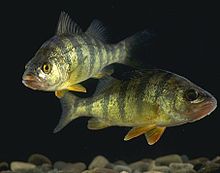Perch
| Perches Temporal range: [1]
| |
|---|---|

| |
| Yellow perch (Perca flavescens) | |
| Scientific classification | |
| Domain: | Eukaryota |
| Kingdom: | Animalia |
| Phylum: | Chordata |
| Class: | Actinopterygii |
| Order: | Perciformes |
| Family: | Percidae |
| Subfamily: | Percinae Rafinesque, 1815 |
| Genus: | Perca Linnaeus, 1758 |
| Type species | |
| Perca fluviatilis Linnaeus, 1758
| |
| Species | |
| |
Perch is a common name for freshwater fish from the genus Perca, which belongs to the family Percidae of the large order Perciformes. The name comes from Greek: πέρκη, romanized: perke, meaning the type species of this genus, the European perch (P. fluviatilis).
Many species of freshwater game fish more or less resemble perch, but belong to different genera. In fact, the exclusively saltwater-dwelling red drum (which belong to a different order Acanthuriformes) is often referred to as a "red perch", though by definition perch are freshwater species. Though many fish are referred to as perch as a common name, to be considered a true perch, the fish must be of the family Percidae.
Species

Most authorities recognize three species within the perch genus:
- The European perch (P. fluviatilis) is primarily found in Europe, but a few can also be found in South Africa, and even as far east on the Southern hemisphere as Australia.[3] This species is typically greenish in color with dark vertical bars on its sides with a red or orange coloring in the tips of its fins. The European perch has been successfully introduced in New Zealand and Australia, where it is known as the redfin perch or English perch. In Australia, larger specimens have been bred, but the species rarely grows heavier than 2.7 kg (6 lb).
- The Balkhash perch (P. schrenkii) is found in Kazakhstan, (in Lake Balkhash and Lake Alakol), Uzbekistan, and China. It has a dark gray/black color on its dorsal side, but the ventral areas of the fish are a lighter silver or even sometimes green color. The Balkhash perch also displays the vertical bars on its sides, similar to the European and yellow perches. In the latter half of the 20th century, the Balkhash perch was introduced into the basins of the Nuru and Chu rivers. The introduction of these fishes to the Nuru and Chu rivers was successful. Because of this success, the population of Balkhash perch in the Balkhash Lake is rarer now. They are similar in size to the yellow and European perches, weighing around 1.5 kg (3 lb 5 oz).[4]
- The yellow perch (P. flavescens), smaller and paler than the European perch (but otherwise nearly identical), is found in North America. In northern areas, it is sometimes referred to as the lake perch. This species is prized for its food quality and has often been raised in hatcheries and introduced into areas in which it is not native. These fish typically only reach a size of about 38 cm (15 in) and 1 kg (2 lb 3 oz).
Anatomy

External anatomy
Perch have a long and round body shape which allows for fast swimming in the water. True perch have "rough" or
External anatomy can be used to determine the sex of perch in multiple ways. Perch have two posterior openings located on their abdomen, the anal and urogenital. In males, the shape of the urogenital opening is round and larger than the anal opening. In females, the urogenital opening is often a V- or U-shape which is a similar size to the anal opening. Also, males usually have a more brown-red colored urogenital opening compared to females.[8]
Internal anatomy
The

Habitats
Perch are classified as carnivores, choosing waters where smaller fish, shellfish, zooplankton, and insect larvae are abundant.[13][14] The perch can be found in the central parts of the United States in freshwater ponds, lakes, streams, or rivers. These fish can be found in freshwater all over the world, and are known to inhabit the Great Lake region, in particular Lake Erie. These fish inhabit bodies of water where vegetation and debris is readily accessible.[15][16][17] In the spring when the perch chooses to spawn, they use vegetation to conceal their eggs from predators.[18]
Fishing
Perch are a popular
Perch grow to around 50 cm (20 in) and 2.3 kg (5 lb) or more, but the most common size caught are around 30 cm (1 ft) and 450 g (1 lb) or less and anything over 40 cm (16 in) and 900 g (2 lb) is considered a prize catch.
References
- ^ "Perca Linnaeus 1758 (perch)".
- ^ Lydon, Alexander Francis (1879), Perca fluviatilis, retrieved 2022-05-10
- .
- ISBN 9780429069468, retrieved 2022-05-10
- ^ Cholmondeley-Pennell, H (1863), English: Head of the European perch (Perca fluviatilis), retrieved 2022-05-10
- ISSN 1469-7998.
- ^ OCLC 3003870.
- ISSN 1522-2055.
- ^ OCLC 1132388392.
- PMID 5738636.
- OCLC 640832481.
- ^ Houseman, Jon (2013-05-22), English: Internal Anatomy of the Perch Perca flavescens., retrieved 2022-05-10
- ISSN 1573-5117.
- ISSN 0906-6691.
- ISSN 0046-5070.
- ISSN 0030-1299.
- ISSN 0012-9658.
- S2CID 13720490.
- ^ "Nederlands record baars 56 cm - Bekijk de foto's, lees het vangstverslag!".
External links
 Media related to Perca at Wikimedia Commons
Media related to Perca at Wikimedia Commons

